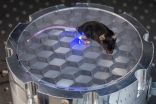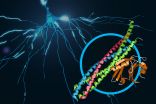The device dramatically expands the scope of research that can be carried out through optogenetics to include experiments involving mice in enclosed spaces or interacting freely with other animals. The work is published in the Aug. 17 edition of Nature Methods.
"This is a new way of delivering wireless power for optogenetics," said Ada Poon, an assistant professor of electrical engineering at Stanford. "It's much smaller and the mouse can move around during an experiment."
The device can be assembled and reconfigured for different uses in a lab, and the plans for the power source are publicly available. "I think other labs will be able to adapt this for their work," Poon said.
Scaling down
Traditionally, optogenetics has required a fiber optic cable attached to a mouse's head to deliver light and control nerves. With this somewhat restrictive headgear, mice can move freely in an open cage but can't navigate an enclosed space or burrow into a pile of sleeping cage-mates the way an unencumbered mouse could. Also, before an experiment a scientist has to handle the mouse to attach the cable, stressing the mouse and possibly altering the outcome of the experiment.
These restrictions limit what can be learned through optogenetics. People have successfully investigated a range of scientific questions including how to relieve tremors in Parkinson's disease, the function of neurons that convey pain and possible treatments for stroke. However, addressing issues with a social component like depression or anxiety or that involve mazes and other types of complex movement is more challenging when the mouse is tethered.
Poon had made a name for herself creating miniature, implantable, wirelessly powered devices. Although that capability was badly needed in the optogenetics world, Poon didn't know it until she attended a neural engineering workshop that brought together faculty from neurosciences and engineering.
At that event Poon met Logan Grosenick, who was a graduate student from the lab of Karl Deisseroth, a Stanford professor of bioengineering and of psychiatry and behavioral sciences who invented optogenetics. But Grosenick didn't have time to lead a collaboration.
Through follow-up conversations, Poon eventually met graduate student Kate Montgomery, who was working in the lab of Scott Delp, professor of bioengineering and of mechanical engineering, and collaborating with Deisseroth.
"Since then our labs have established a lasting scientific relationship," said Montgomery, who has an interdisciplinary fellowship through Stanford Bio-X. She and graduate student Alexander Yeh, who worked in Poon's lab, were co-first authors on the research paper.
Before a new wave of tinfoil hat designs takes over the Internet, it is important to clarify one point: Optogenetics only works on nerves that have been carefully prepared to contain the proteins that respond to light. In the lab, scientists either breed mice to contain those proteins in select groups of nerves or they carefully and painstakingly inject viruses carrying the protein DNA into nerves the size of dental floss. Shining a light - whether through a fiber optic cable or a wireless device - on neurons that haven't been prepared has no effect.
Powering up
Poon said that developing the tiny device to deliver light was the easy part. She and her colleagues developed that and had it working a few months after the workshop. What was hard was figuring out how to power it over a large area without compromising power efficiency.
In behavioral experiments, the mouse would be moving all around, and the researchers needed a way of tracking that movement to provide localized power. Poon knew other labs were tackling the same problem using bulky devices that affix to the skull and complex arrays of coils paired with sensors to locate the mouse and deliver localized power.
"We were lazy," Poon said. "That sounded like a lot of work."
So instead she got what she called a crazy idea to use the mouse's own body to transfer radio frequency energy that was just the right wavelength to resonate in a mouse. Crazy maybe, but it worked, and she published the results Aug. 4 in Physical Review Applied with co-first authors John Ho, a graduate student who is now an assistant professor at the National University of Singapore, and Yuji Tanabe, a research associate in her lab.
Poon had the idea but initially didn't know how to build a chamber to amplify and store radio frequency energy. She and Tanabe consulted with Tanabe's father, who had worked at Stanford's SLAC research center and knew a thing or two about machining such a cavity, and then traveled to Japan to do the initial assembly and testing.
Tanabe's dad referred to their final chamber as a "kindergarten project," but it worked. However, in its native state the open chamber would radiate energy in all directions. Instead, a grid was overlaid on top of the chamber with holes that were smaller than the wavelength of the energy contained within. That essentially trapped the energy inside the chamber.
The key is that there's a bit of wiggle room at the grid. So if something like, say, a mouse paw were present, it would come in contact with the boundary of all that stored energy. And remember how the wavelength is the exact wavelength that resonates in mice? The mouse essentially becomes a conduit, releasing the energy from the chamber into its body, where it is captured by a 2 mm coil in the device.
Wherever the mouse moves, its body comes in contact with the energy, drawing it in and powering the device. Elsewhere, the energy stays tidily contained. In this way, the mouse becomes its own localizing device for power delivery.
This novel way of delivering power is what allowed the team to create such a small device. And in this case, size is critical. The device is the first attempt at wireless optogenetics that is small enough to be implanted under the skin and may even be able to trigger a signal in muscles or some organs, which were previously not accessible to optogenetics.
The team says the device and the novel powering mechanism open the door to a range of new experiments to better understand and treat mental health disorders, movement disorders and diseases of the internal organs. They have a Stanford Bio-X grant to explore and possibly develop new treatments for chronic pain.
INFORMATION:
For more Stanford experts on electrical engineering and other topics, visit Stanford Experts.

